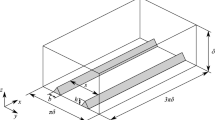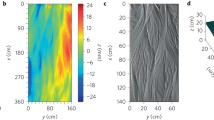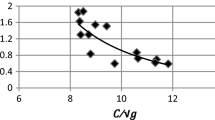Abstract
The curvature-driven secondary flow in sinuous submarine channels has been a subject of considerable interest and controversy. Here, results from numerical model studies involving saline flow in laboratory-scale channels are presented. A 3D finite volume model of density and turbidity currents is used and simulations are run with different inflow discharges and channel-axis slopes. The simulation results show strong influence of bend wave length, channel gradient, confinement and cross sectional shape on the structure of secondary flow in submarine channels. Major findings are: (i) reversal of secondary flow in submarine channels is strongly associated with a tight bend characterized by a smaller wave length to width ratio or larger wave number, (ii) for the same inflow condition and planform characteristics, a trapezoidal channel cross section is more favorable to secondary flow reversal than a rectangular cross section, (iii) lateral convection resulting from the interaction between in-channel and overbank flows leads to the reversal of secondary flow in an unconfined channel at a lower channel slope than in a confined channel with the same dimensions, (iv) flow discharge has only nominal effect on the secondary flow in submarine channels.
















Similar content being viewed by others
References
Abad JD, Garcia MH (2009a) Experiments in a high-amplitude kinoshita meandering channel: 1. implications of bend orientation on mean and turbulent flow structure. Water Resour Res 45(2):W02401. doi:10.1029/2008WR007016
Abad JD, Garcia MH (2009b) Experiments in a high-amplitude kinoshita meandering channel: 2. implications of bend orientation on bed morphodynamics. Water Resour Res 45(2):W02402
Abad JD, Sequeiros OE, Spinewine B, Pirmez C, Garcia MH, Parker G (2011) Secondary current of saline underflow in a highly meandering channel: experiments and theory. J Sediment Res 81(11):787–813. doi:10.2110/jsr.2011.61
Amos KJ, Peakall J, Bradbury PW, Roberts M, Keevil G, Gupta S (2010) The influence of bend amplitude and planform morphology on flow and sedimentation in submarine channels. Mar Petrol Geol 27(7):1431–1447. doi:10.1016/j.marpetgeo.2010.05.004
Cebeci T, Bradshaw P (1977) Momentum transfer in boundary layers. Hemisphere Publishing Corp. and McGraw-Hill Book Co., Washington DC and New York, p 1
Clark J, Pickering K (1996) Architectural elements and growth patterns of submarine channels: applications to hydrocarbon exploration. AAPG Bull 80:194–221
Corney R, Peakall J, Parsons D, Elliott L, Amos K, Best J, Keevil G, Ingham D (2006) The orientation of helical flow in curved channels. Sedimentology 53:249–257
Corney RKT, Peakall J, Parsons DR, Elliott L, Best JL, Thomas RE, Keevil GM, Ingham DB, Amos KJ (2008) Reply to discussion of Imran et al. on “The orientation of helical flow in curved channels” by Corney et al., sedimentology, 53, 249–257. Sedimentology 55(1):241–247. doi:10.1111/j.1365-3091.2007.00925.x
Cossu R, Wells MG (2010) Coriolis forces influence the secondary circulation of gravity currents flowing in large-scale sinuous submarine channel systems. Geophys Res Lett 37(17):L17603. doi:10.1029/2010GL044296
Dorrell RM, Darby SE, Peakall J, Sumner EJ, Parsons DR, Wynn RB (2013) Superelevation and overspill control secondary flow dynamics in submarine channels. J Geophys Res 118:3895–3915. doi:10.1002/jgrc.20277
Ellison T, Turner J (1959) Turbulent entrainment in stratified flows. J Fluid Mech 6:423–448
Engelund F (1974) Flow and bed topography in channel bends. J Hydraul Div 100:1631–1648
Ferziger J, Peric M (1999) Computational methods for fluid dynamics, 2nd edn. Springer-Verlag, New York
Garcia M, Parker G (1993) Experiments on the entrainment of sediment into suspension by a dense bottom current. J Geophys Res 98(C3):4793–4807. doi:10.1029/92JC02404
Gottlieb L (1976) Three-dimensional flow pattern and bed topography in meandering channels, Ph.D. Thesis, Institute of Hydrodynamics and Hydraulic Engineering, Technical University of Denmark
Henkes RA, Flugt WM, Hoogendoorn CJ (1991) Natural convection flow in a square cavity calculated with low-Reynolds number turbulence models. Int J Heat Mass Transf 34:1543–1557
Huang H, Imran J, Pirmez C (2005) Numerical model of turbidity currents with a deforming bottom boundary. J Hydraul Eng 131:283–293
Huang H, Imran J, Pirmez C (2007) Numerical modeling of poorly sorted depositional turbidity currents. J Geophys Res 112:C01014. doi:10.1029/2006JC003,778
Huang H, Imran J, Pirmez C (2012) The depositional characteristics of turbidity currents in submarine sinuous channels. Mar Geol 329—-331:93–102. doi:10.1016/j.margeo.2012.08.003
Ikeda S, Nishimura T (1986) Flow and bed profile in meandering sand-silt rivers. J Hydraul Eng 112(7):562–576
Ikeda S, Parker G, Sawai K (1981) Bend theory of river meanders part 1. linear development. J Fluid Mech 112:363–377
Imran J, Parker G, Pirmez C (1999) A nonlinear model of flow in meandering submarine and subaerial channels. J Fluid Mech 400:295–331
Imran J, Islam M, Huang H, Kassem A, Pirmez C, Dickerson J, Parker G (2007) Helical flow couplets in submarine gravity underflows. Geology 35(7):659–662
Imran J, Islam MA, Kassem A (2008) ”The orientation of helical flow in curved channels” by Corney et al., Sedimentology, vol. 53, pp. 249257 discussion. Sedimentology 55(1):235–239. doi:10.1111/j.1365-3091.2007.00924.x
Islam M (2007) Experimental modeling of gravity underfow in submarine channels, Ph.D Thesis, University of South Carolina
Islam M, Imran J, Pirmez C, Cantelli A (2008) Flow splitting modifies the helical motion in submarine channels. Geophys Res Lett 35:L22603. doi:10.1029/2008GL034,995
Janocko M, Cartigny M, Nemec W, Hansen E (2013) Turbidity current hydraulics and sediment deposition in erodible sinuous channels: Laboratory experiments and numerical simulations. Mar Petrol Geol 41:222–249. doi:10.1016/j.marpetgeo.2012.08.012
Johannesson H, Parker G (1989a) Linear theory of river meanders. In: Ikeda S, Parker G (eds) River Engineering, vol 12. AGU Monograph, Washington DC, pp 181–214
Johannesson H, Parker G (1989b) Secondary flow in mildly sinuous channel. J Hydraul Eng 115:289–308
Kassem A, Imran J (2004) Three-dimensional modeling and analysis of density current, II. Flow in sinuous confined and unconfined channels. J Hydraul Res 42(6):591–602
Keevil G, Peakall J, Best J, Amos K (2006) Flow structure in sinuous submarine channels: velocity and turbulence structure of an experimental submarine channel. Mar Geol 229:241–257
Keevil GM, Peakall J, Best JL (2007) The influence of scale, slope and channel geometry on the flow dynamics of submarine channels. Mar Petrol Geol 24(6–9):487–503. doi:10.1016/j.marpetgeo.2007.01.009
Kitanidis PK, Kennedy JF (1984) Secondary current and river-meander formation. J Fluid Mech 144(1):217–229
Kolla V, Posamentier H, Wood L (2007) Deep-water and fluvial sinuous channels-characteristics, similarities and dissimilarities, and modes of formation. Mar Petrol Geol 24(6–9):388–405. doi:10.1016/j.marpetgeo.2007.01.007
Komar P (1969) The channelized flow of turbidity currents with application to monterey deep-sea fan channel. J Geophys Res 74:4544–4557
Mohrig D, Buttles J (2007) Deep turbidity currents in shallow channels. Geology 35(2):155–158
Nakajima T, Peakall J, McCaffrey WD, Paton DA, Thompson PJP (2009) Outer-bank bars: a new intra-channel architectural element within sinuous submarine slope channels. J Sediment Res 79:872–886. doi:10.2110/jsr.2009.094
Parsons DR, Peakall J, Aksu AE, Flood RD, Hiscott RN, Beşiktepe Ş, Mouland D (2010) Gravity-driven flow in a submarine channel bend: direct field evidence of helical flow reversal. Geology 38(12):1063–1066
Peakall J, McCaffrey B, Kneller B (2000) A process model for the evolution and architecture of sinuous submarine channels. J Sediment Res 70:434–448
Pirmez C (1994) Growth of a submarine meandering channel-levee system on the Amazon Fan, Ph.D. Thesis, Columbia University. USA, New York
Pirmez C, Imran J (2003) Reconstruction of turbidity currents in Amazon channel. Mar Petrol Geol 20(6–8):823–849. doi:10.1016/j.marpetgeo.2003.03.005
Pittaluga MB, Nobile G, Seminara G (2009) A nonlinear model for river meandering. Water Resour Res 45(4):W04432. doi:10.1029/2008WR007298
Rodi W (1984) Turbulence models and their applications in hydraulics, Monograph, International Association for Hydraulic Research, Delft, The Netherlands, Monograph, Delft, The Netherlands
Rozovskii I (1961) Flow of water in bends of open channels, Translation OTS 60–51133, Y. U.S. Department of Commerce, Washington, DC, Prushansky, Office of Technical Service
Serchi GF, Peakall J, Ingham DB, Burns AD (2011) A unifying computational fluid dynamics investigation on the river-like to river-reversed secondary circulation in submarine channel bends. J Geophys Res 116:C06012
Stacey M, Bowen A (1988) The vertical structure of turbidity currents and a necessary condition for self-maintenance. J Geophys Res 93(C4):3543–3553
Straub K, Mohrig D, McElroy B, Buttles J, Pirmez C (2008) Interactions between turbidity currents and topography in aggrading sinuous submarine channels: a laboratory study. GSA Bull 120:368–385
Wynn RB, Cronin BT, Peakall J (2007) Sinuous deep-water channels: genesis, geometry and architecture. Mar Petrol Geol 24(6–9):341–387. doi:10.1016/j.marpetgeo.2007.06.001
Acknowledgments
Funding supports from the National Science Foundation Marine Geology Program (Grant number 1061244) and Shell International Exploration and Production Company to J. Imran are gratefully acknowledged.
Author information
Authors and Affiliations
Corresponding author
Rights and permissions
About this article
Cite this article
Ezz, H., Imran, J. Curvature-induced secondary flow in submarine channels. Environ Fluid Mech 14, 343–370 (2014). https://doi.org/10.1007/s10652-014-9345-4
Received:
Accepted:
Published:
Issue Date:
DOI: https://doi.org/10.1007/s10652-014-9345-4




